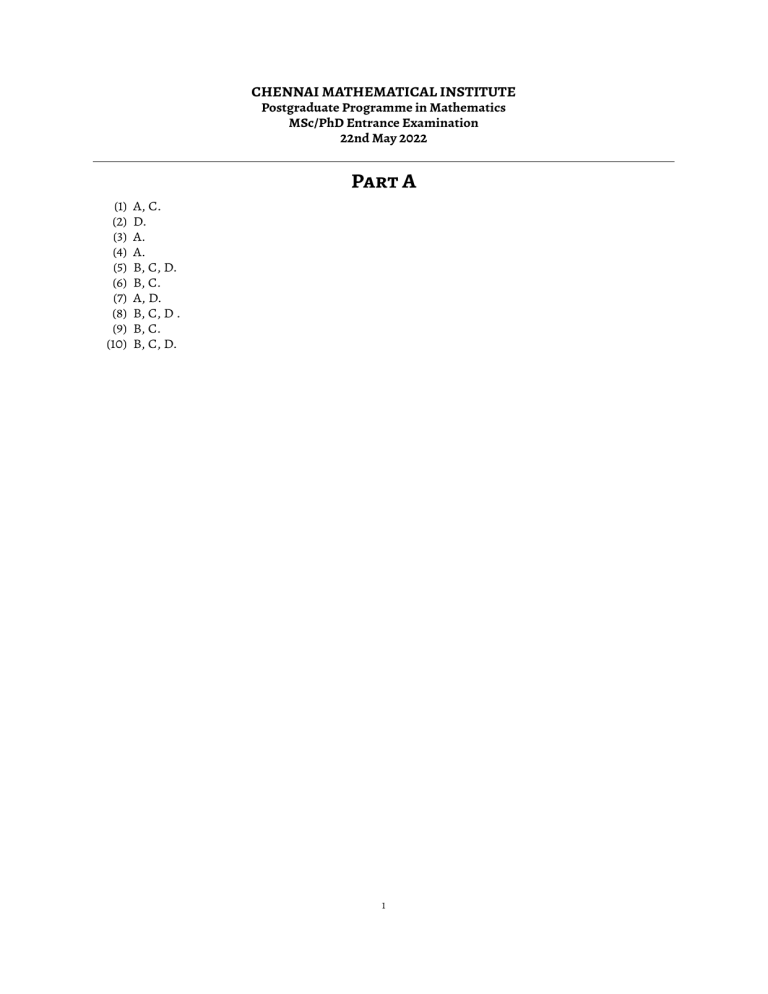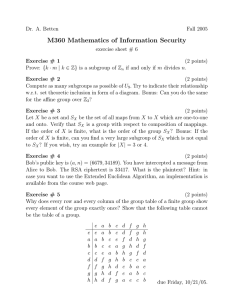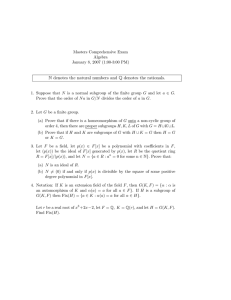
CHENNAI MATHEMATICAL INSTITUTE
Postgraduate Programme in Mathematics
MSc/PhD Entrance Examination
22nd May 2022
Part A
(1)
(2)
(3)
(4)
(5)
(6)
(7)
(8)
(9)
(10)
A, C.
D.
A.
A.
B, C, D.
B, C.
A, D.
B, C, D .
B, C.
B, C, D.
1
Part B
(11) (A) Multiplying by the transpose, we get
𝑡 1 3 = 1 1 1 𝐴 𝐴 1 = 1 1 1 𝜆 2
1
so 𝜆 = ±1.
(B) Similarly,
1
1 = 3𝜆 2
1
𝑥
𝑡 1
𝜆(𝑥 + 𝑦 + 𝑧) = 1 1 1 𝜆 𝑦 = 1 1 1 𝐴 𝐴 −1 = 0
𝑧
0
so 𝑥 + 𝑦 + 𝑧 = 0 since 𝜆 ≠ 0.
(12) The ratio above can be expressed as
𝑗 𝑎
1 Í𝑛
𝑗=1 ( 𝑛 )
𝑛
.
Í
(1 + 𝑛1 )𝑎−1 · 𝑛1 𝑛𝑗=1 (𝑎 + 𝑛𝑗 )
∫1
In the limit, the numerator becomes the integral 0 𝑥 𝑎𝑑𝑥. Likewise, the denominator tends to
∫1
(𝑎 + 𝑥)𝑑𝑥. Setting 𝑆 (𝑎) = 1/60 gives the quadratic equation 2𝑎 2 + 3𝑎 − 119 = 0. So the answer
0
is −3/2.
(13) By way of contradiction, let 𝛼 ∈ 𝑉 \ 𝑓 (𝑈 ). Find a countable collection of nested closed balls {𝐶𝑛 }
around 𝛼 whose intersection is {𝛼 }. Then
∩𝑛 𝑓 −1 (𝐶𝑛 ) = ∅.
But then 𝑓 −1 (𝐶𝑛 ) = 𝜙 for some 𝑛 and hence the interior of 𝐶𝑛 contains 𝛼 and is in 𝑉 \ 𝑓 (𝑈 ).
So 𝑉 \ 𝑓 (𝑈 ) is open, it is also closed, contradicting the hypothesis that 𝑉 is connected. Thus
𝑓 (𝑈 ) = 𝑉 .
(14) (A) By way of contradiction, assume that 𝑝 and 𝑞 are distinct prime numbers that divide |𝐺 |.
Then 𝐺 has subgroups of orders 𝑝 and 𝑞, so such an 𝑁 cannot exist. Hence 𝐺 is a finite
𝑝-group for some 𝑝.
(B) Hence the centre 𝑍 (𝐺) ≠ {1𝐺 }. Since 𝑍 (𝐺) is abelian, and a normal subgroup of 𝐺 and 𝑁 a
subgroup of 𝑍 (𝐺), it follows that 𝑁 is a normal subgroup of 𝐺.
(15) Chose 𝛼 ∈ C such that <(𝛼) < 0 and <(𝛼 𝑓 0 (1)) > 0. This is possible if 𝑓 0 (1) ∉ R. Since
𝑓 (𝐷) ⊂ 𝐷, for small 𝑡 > 0
𝑓 (1 + 𝑡𝛼) − 1
<0
<
𝑡
and hence as 𝑡 −→ 0+ , <(𝛼 𝑓 0 (1)) ≤ 0.
For the second part, note that by Schwartz lemma and 0 < 𝑡 < 1, |𝑓 (𝑡)| ≤ 𝑡 and hence
|𝑓 (𝑡) − 1|
1 − |𝑓 (𝑡)|
≥
≥1
1−𝑡
1−𝑡
and as 𝑡 −→ 1, we have the inequality.
(16) Since every
Ð𝑟finite extension of a finite field is Galois, 𝐹 is infinite By way of contradiction, assume
that 𝑉 = 𝑖=1 𝑉𝑖 . Pick 𝑥 ≠ 0 ∈ 𝑉1 and 𝑦 ∈ 𝑉 \ 𝑉1 . Then there exists 𝑗 > 1Ðsuch that 𝑥 + 𝛼𝑦 ∈ 𝑉𝑗
for infinitely many 𝛼 ∈ 𝐹 × . Hence 𝑦 ∈ 𝑉𝑗 and, so, 𝑥 ∈ 𝑉𝑗 . Therefore 𝑉 = 𝑟𝑖=2 𝑉𝑖 . Repeating this
argument, we get a contradiction.
2
(17∗ ) Fibre is
C[𝑋, 𝑌 ]/(𝑋𝑌 − 1, 𝑋 + 𝛼𝑌 − 𝛽).
If 𝛼 = 𝛽 = 0, then it is the zero ring since (𝑋𝑌 − 1, 𝑋 ) = C[𝑋, 𝑌 ]. Otherwise,
C[𝑋, 𝑌 ]/(𝑋𝑌 − 1, 𝑋 + 𝛼𝑌 − 𝛽) ' C[𝑋 ]/(−(𝛼𝑌 − 𝛽)𝑌 − 1) ' C[𝑌 ]/((𝛼𝑌 − 𝛽)𝑌 + 1)
The equation 𝛼𝑌 2 − 𝛽𝑌 + 1 has at least one solution; it has exactly one solution if and only if
𝛽 2 = 4𝛼. Hence for 𝑛 = 0, the answer is {(0, 0)}. For each (𝛼, 𝛽) with 𝛽 2 = 4𝛼, the fibre has
exactly one prime ideal; for all other values of (𝛼, 𝛽), the fibre has exactly two prime ideals.
(18∗ ) (A) Consider the projection maps 𝜋𝑖 : 𝑄 −→ R, (𝑦1, . . .) ↦→ 𝑦𝑖 . Then
Ù
1
𝑄2 =
𝜋𝑖−1 ( [0, ])
𝑛
𝑖 ≥1
so it is a closed subset of 𝑄. Since 𝑄 is compact by Tychonoff’s theorem, 𝑄 2 is compact.
(B) The maps (𝑦1, . . .) ↦→ 𝑖𝑦𝑖 is continuous for each 𝑖, so 𝐷 is continuous. It is bijective. Since 𝑄
is Hausdorff and 𝑄 2 compact, 𝐷 is continuous.
(C) Take 𝐿 = ℓ2 and a = (1, 21 , . . . , 𝑛1 , . . . ). (Note that 𝑄 2 ⊆ ℓ2 .)
(D) 𝐷 is a homeomorphism and 𝑆 ◦ 𝐷 is continuous.
(19∗ ) (A) is false since the polynomial 𝑋 12 − 𝑝 has two real roots.
(B) is a consequence of the fact that any degree 11 polynomial has a real root.
(C) If the group Aut(𝐸) of all field automorphisms of 𝐸 has odd order, then every embedding
𝐸 −→ C is real. note that if 𝜎 is a complex embedding, then complex conjugation yields a
nontrivial automorphism 𝐸 of order 2.
(20∗ ) (A) 𝑑𝑋 (𝑎, −𝑎) = 2𝑅. Hence 2𝑅/𝜆 ≤ 𝑑𝑌 (𝑓 (𝑎), 𝑓 (−𝑎)) ≤ 𝐿𝑅 + 2, so 𝐿𝑅 ≥ 2𝑅/𝜆 − 2. 𝐿𝑅 =
𝑑𝑌 (𝑓 (𝑎), 𝑓 (𝑏)) ≤ 𝜆𝑑𝑋 (𝑎, 𝑏). Hence 𝑑𝑋 (𝑎, 𝑏) ≥ 𝐿𝑅 /𝜆 ≥ 2𝑅/𝜆 2 − 2/𝜆.
(B) Note that 𝑓¯(𝐶 1 ) = 𝑓¯(𝐶 2 ) = 𝑓¯(𝐶𝑅 ). Hence there exist such 𝑥𝑖 as asserted. Since {𝑓 (𝑥 1 ), 𝑓 (𝑥 2 )} ⊆
𝑓 (𝑎)+𝑓 (𝑏)
S1 × {
}, it follows that 𝑑𝑌 (𝑓 (𝑥 1 ), 𝑓 (𝑥 2 )) ≤ 2.
2
(C) 𝑑𝑌 (𝑓 (𝑥 1 ), 𝑓 (𝑎)) ≥ 𝐿𝑅 /2, so 𝑑𝑋 (𝑥 1, 𝑎) ≥ 𝐿𝑅 /2𝜆 ≥ (𝑅 − 𝜆)/𝜆 2 . Similarly 𝑑𝑋 (𝑥 2, 𝑎) ≥ 𝐿𝑅 /2𝜆 ≥
(𝑅 − 𝜆)/𝜆 2 . Choose 𝑎𝑖 ∈ 𝐶𝑖 be such that 𝑑𝑋 (𝑎, 𝑎𝑖 ) = (𝑅 − 𝜆)/𝜆 2 ; Elementary trigonometric
arguments show that for all 𝑅 0, 𝑑𝑋 (𝑎 1, 𝑎 2 ) > 2𝜆. Hence 𝑑𝑋 (𝑥 1, 𝑥 2 ) > 2𝜆. Therefore
𝑑𝑌 (𝑓 (𝑥 1 ), 𝑓 (𝑥 2 )) > 2.
(D) There does not exist any bilipschitz map 𝑋 −→ 𝑌 .
3



